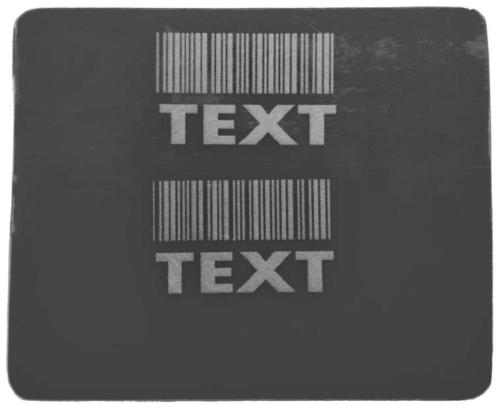Color change aid used for preparing white or light-colored marks and preparation method thereof
A technology of changing auxiliary agent and auxiliary agent, applied in the field of color changing auxiliary agent and its preparation, can solve the problems of inability to realize white or light-colored marking of polymers of different colors, limited application, etc., and achieves easy operation, low energy consumption, and preparation Simple and efficient process
- Summary
- Abstract
- Description
- Claims
- Application Information
AI Technical Summary
Problems solved by technology
Method used
Image
Examples
Embodiment 1
[0051] Laser absorber: silver powder, particle size (D 50 ) is 0.4 μm;
[0052] Thermoplastic polymers: polyoxymethylene (POM), Shenhua MC90, a polyoxymethylene copolymer;
[0053] Carrier polymer: ethylene-octene copolymer (POE), DuPont 8200;
[0054] Put 80 parts by weight of polyoxymethylene, 10 parts by weight of silver powder and 10 parts by weight of ethylene-octene copolymer in a high-speed mixer and mix them uniformly; then add the above-mentioned mixture to a twin-screw extruder for blending and extrusion, and granulate. That is, the laser color-changing additive of the present invention is obtained. The temperature during the blending and extrusion process is controlled at 180°C to 230°C;
[0055] Next, the obtained laser color-changing auxiliary agent is added to polypropylene resin particles at 2wt%, and 0.1wt% of pigment red 254 (organic red) is added at the same time, and then blended by a twin-screw extruder, granulated, and extruded The temperature is 170°C...
Embodiment 2
[0057] Laser absorber: silver powder, particle size (D 50 ) is 0.4 μm;
[0058] Thermoplastic polymers: polyoxymethylene (POM), Shenhua MC90, a polyoxymethylene copolymer;
[0059] Carrier polymer 1: ethylene-octene copolymer (POE), DuPont 8200;
[0060] Carrier polymer 2: Ethylene-methyl acrylate-glycidyl methacrylate copolymer, DuPont PTW.
[0061] 80 parts by weight of polyoxymethylene, 10 parts by weight of silver powder, 7 parts by weight of ethylene-octene copolymer, and 3 parts by weight of ethylene-methyl acrylate-glycidyl methacrylate copolymer are placed in a high-speed mixer and mixed uniformly; The above-mentioned mixed materials are added to a twin-screw extruder for blending and extruding, and granulated to obtain the laser color-changing additive of the present invention. The temperature during the blending and extrusion process is controlled at 180°C to 230°C;
[0062] Next, the obtained laser color-changing auxiliary agent is added to polypropylene resin p...
Embodiment 3
[0064] Laser absorber: silver powder, particle size (D 50 ) is 0.4μm; titanium dioxide, particle size (D 50 ) is 0.6 μm;
[0065] Thermoplastic polymers: polyoxymethylene (POM), Shenhua MC90, a polyoxymethylene copolymer;
[0066] Carrier polymer 1: ethylene-octene copolymer (POE), DuPont 8200;
[0067] Carrier polymer 2: Ethylene-methyl acrylate-glycidyl methacrylate copolymer, DuPont PTW.
[0068] 80 parts by weight of polyoxymethylene, 8 parts by weight of silver powder, 2 parts by weight of titanium dioxide, 7 parts by weight of ethylene-octene copolymer, and 3 parts by weight of ethylene-methyl acrylate-glycidyl methacrylate copolymer are placed in a high-speed mixer Mix evenly; then add the above-mentioned mixture into a twin-screw extruder for blending and extrusion, and granulate to obtain the laser color change additive of the present invention. The temperature during the blending and extrusion process is controlled at 180°C to 230°C;
[0069] Next, the obtained ...
PUM
| Property | Measurement | Unit |
|---|---|---|
| particle diameter | aaaaa | aaaaa |
| particle diameter | aaaaa | aaaaa |
| wavelength | aaaaa | aaaaa |
Abstract
Description
Claims
Application Information
 Login to View More
Login to View More - R&D
- Intellectual Property
- Life Sciences
- Materials
- Tech Scout
- Unparalleled Data Quality
- Higher Quality Content
- 60% Fewer Hallucinations
Browse by: Latest US Patents, China's latest patents, Technical Efficacy Thesaurus, Application Domain, Technology Topic, Popular Technical Reports.
© 2025 PatSnap. All rights reserved.Legal|Privacy policy|Modern Slavery Act Transparency Statement|Sitemap|About US| Contact US: help@patsnap.com



